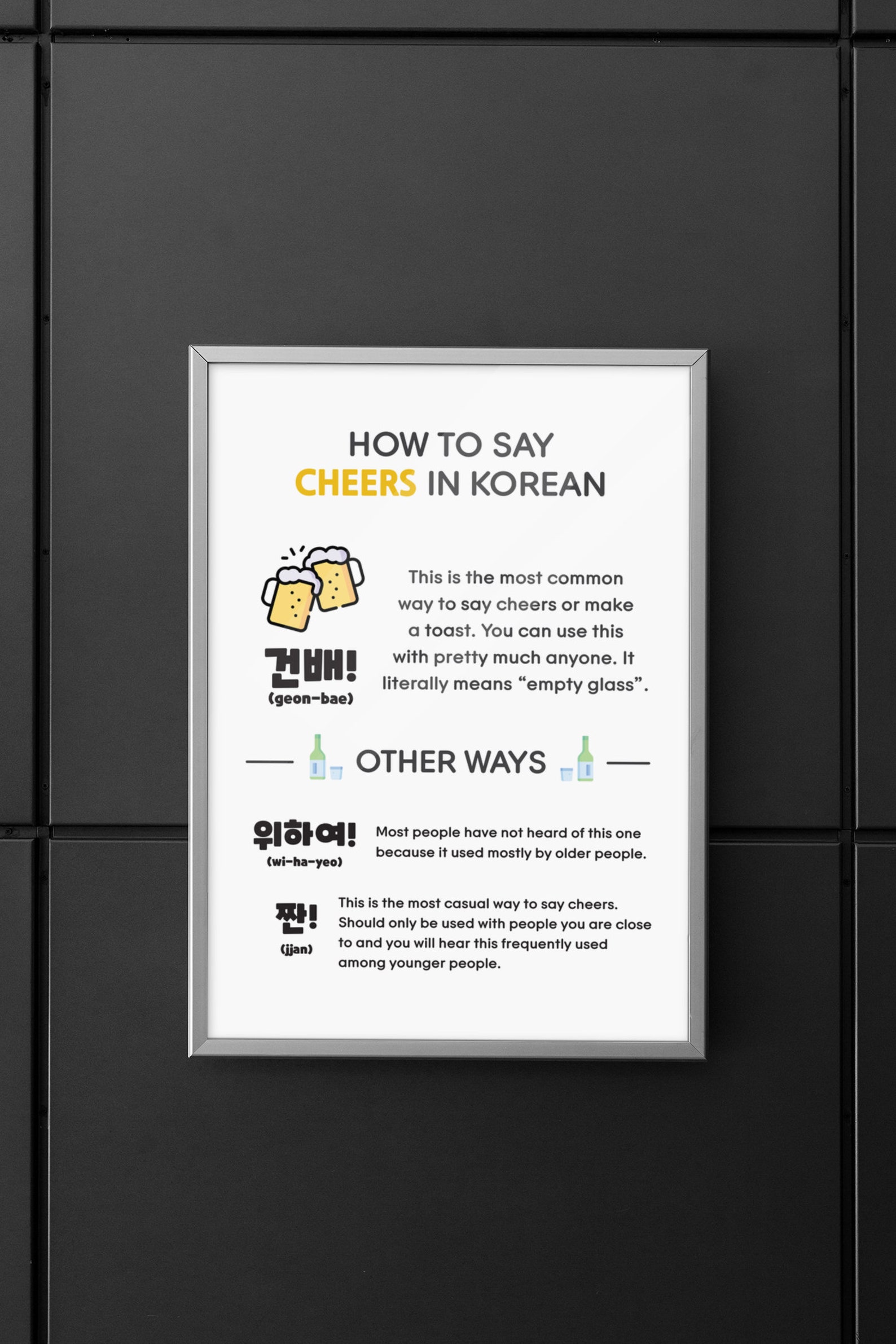Cheers In Korean Language: A Complete Guide To Mastering The Art Of Toasting
Whether you're planning a trip to Seoul, attending a Korean wedding, or simply enjoying a night out with Korean friends, knowing how to toast properly can make all the difference. The Korean language offers various ways to express this celebratory sentiment, and each one carries its own nuance and cultural significance. In this article, we’ll dive deep into the meaning, pronunciation, and cultural context of "cheers in Korean language," ensuring you’re fully prepared for any occasion.
When it comes to celebrations, Koreans take their traditions seriously. Saying "cheers" in Korean isn't just about raising a glass; it's about connecting with others, showing respect, and embracing the spirit of the moment. From casual gatherings to formal events, the phrase "cheers in Korean language" can be adapted to suit any setting. This guide will walk you through the different expressions used for toasting, their meanings, and the proper etiquette to follow when raising your glass in Korea.
For those eager to explore the vibrant Korean culture, mastering the art of toasting is a fantastic starting point. Whether you're a language enthusiast, a traveler, or someone who loves to celebrate life's moments, this article will provide you with everything you need to know about "cheers in Korean language." By the end of this guide, you'll not only know how to say "cheers" but also understand the deeper cultural significance behind it.
Read also:Keyshia Cole Death Unveiling The Truth Behind The Rumors
Table of Contents
- What Does "Cheers" Mean in Korean?
- How to Say "Cheers" in Korean Language?
- Why Is "Cheers" Important in Korean Culture?
- Can You Toast Without Alcohol in Korea?
- What Are the Different Ways to Toast in Korean?
- Is There a Formal Way to Say "Cheers" in Korean?
- How Do You Pronounce "Cheers" in Korean Language?
- What Are the Best Occasions to Use "Cheers" in Korean?
- How Can You Master the Art of Korean Toasting?
- What Are the Common Mistakes to Avoid When Saying "Cheers" in Korean?
What Does "Cheers" Mean in Korean?
In Korean, "cheers" is most commonly expressed as "건배" (pronounced "geonbae"). This phrase literally translates to "empty glass," signifying the act of drinking until the glass is empty as a gesture of celebration. The concept of "cheers in Korean language" is deeply rooted in the idea of togetherness and shared joy. When you say "건배," you're not just raising your glass; you're inviting everyone to partake in the moment and celebrate as one.
Understanding the meaning behind "cheers" in Korean goes beyond the literal translation. It reflects the importance of community and connection in Korean culture. Whether you're at a casual dinner or a formal banquet, saying "건배" is a way to honor the people around you and express gratitude for their presence. This phrase is versatile and can be used in a variety of settings, making it an essential part of any Korean language learner's vocabulary.
How to Say "Cheers" in Korean Language?
Learning how to say "cheers" in Korean is easier than you might think. The phrase "건배" (geonbae) is widely used and understood across Korea. To pronounce it correctly, start with a soft "g" sound, followed by "eon," and finish with "bae" (rhymes with "day"). Practicing this phrase will help you feel more confident when participating in Korean celebrations.
Aside from "건배," there are other ways to express "cheers in Korean language" depending on the context. For example, you might hear "위하여" (wihaeyo), which means "for the sake of" or "in honor of." This phrase is often used in more formal settings, such as business dinners or official events. By mastering these variations, you'll be well-prepared for any occasion where toasting is involved.
Why Is "Cheers" Important in Korean Culture?
Toast-making is an integral part of Korean celebrations, whether it's a wedding, birthday, or corporate event. Saying "cheers" in Korean language is more than just a social ritual; it's a way to show respect, gratitude, and camaraderie. In Korean culture, sharing a drink and raising a toast symbolizes unity and the strengthening of bonds between individuals.
Koreans place great importance on hierarchy and etiquette, and this extends to how they toast. For instance, it's customary to hold your glass with both hands when offering a toast to someone older or in a higher position. This gesture demonstrates respect and humility, which are highly valued in Korean society. Understanding the cultural significance of "cheers in Korean language" will help you navigate social situations with ease and confidence.
Read also:Unveiling The Truth Behind Tim Burton Cheating Allegations A Deep Dive
Can You Toast Without Alcohol in Korea?
While alcohol is often associated with toasting in Korea, it's not a strict requirement. Non-alcoholic beverages like juice, soda, or even water can be used for a toast. This flexibility makes "cheers in Korean language" accessible to everyone, regardless of their preferences or restrictions.
That said, alcohol plays a significant role in Korean drinking culture, with soju and makgeolli being popular choices for toasting. If you're participating in a toast with alcohol, it's important to follow the proper etiquette, such as turning away slightly when drinking in front of someone older. These small gestures show respect and consideration, which are key aspects of Korean culture.
What Are the Different Ways to Toast in Korean?
There are several ways to express "cheers" in Korean language, each suited to different contexts. Here are some common variations:
- 건배 (Geonbae): The most widely used term for "cheers," suitable for casual and formal settings.
- 위하여 (Wihaeyo): A more formal phrase meaning "for the sake of" or "in honor of."
- 한잔해요 (Hanjan haeyo): Literally "let's have a drink," often used in informal gatherings.
- 다 같이 (Da gachi): Meaning "all together," this phrase is used to encourage everyone to raise their glasses simultaneously.
By familiarizing yourself with these variations, you'll be able to adapt your toast to the occasion and the people you're with. This flexibility is key to mastering the art of toasting in Korean culture.
Is There a Formal Way to Say "Cheers" in Korean?
Yes, there is a formal way to say "cheers" in Korean language, and it’s important to use it in appropriate settings. The phrase "위하여" (wihaeyo) is often used in formal situations, such as business dinners, official ceremonies, or when toasting someone of higher status. This phrase conveys respect and is a polite way to acknowledge the occasion.
In formal settings, it's also essential to follow proper etiquette. For example, you should hold your glass with both hands and bow slightly when offering a toast. These gestures demonstrate your understanding of Korean cultural norms and your respect for the people around you.
How Do You Pronounce "Cheers" in Korean Language?
Pronouncing "cheers" in Korean language correctly is crucial for making a good impression. The phrase "건배" (geonbae) is pronounced with a soft "g" sound, followed by "eon," and ending with "bae." To practice, break the word into syllables: "geon-bae." Repeat it slowly at first, then gradually increase your speed until it feels natural.
If you're unsure about your pronunciation, consider listening to native speakers or using language apps to refine your skills. Mastering the correct pronunciation of "cheers in Korean language" will help you feel more confident and authentic when participating in Korean celebrations.
What Are the Best Occasions to Use "Cheers" in Korean?
There are countless occasions where saying "cheers" in Korean language is appropriate. Some of the most common include:
- Weddings and anniversaries
- Birthday parties and milestone celebrations
- Business dinners and corporate events
- Festivals and holidays like Chuseok or Lunar New Year
- Casual get-togethers with friends or family
Regardless of the occasion, saying "cheers" in Korean is a way to celebrate shared moments and strengthen relationships. It's a phrase that transcends language barriers and brings people together in joy and camaraderie.
How Can You Master the Art of Korean Toasting?
Mastering the art of Korean toasting involves more than just learning the phrase "cheers in Korean language." It requires an understanding of cultural nuances, proper etiquette, and the ability to adapt to different settings. Here are some tips to help you become a confident toaster:
- Practice the pronunciation of "건배" (geonbae) until it feels natural.
- Learn the appropriate gestures, such as holding your glass with both hands.
- Understand the hierarchy and show respect to elders or those in higher positions.
- Be mindful of the context and choose the right phrase for the occasion.
By following these guidelines, you'll be able to toast like a pro and make a positive impression on your Korean friends or colleagues.
What Are the Common Mistakes to Avoid When Saying "Cheers" in Korean?
Even well-intentioned individuals can make mistakes when saying "cheers" in Korean language. Here are some common pitfalls to avoid:
- Using informal language in formal settings
- Not holding your glass with both hands when toasting someone older
- Pronouncing "건배" incorrectly, which can lead to confusion
- Drinking before the eldest person or host has started
By being aware of these mistakes, you can ensure that your toast is both respectful and memorable. Remember, the key to successful toasting lies in understanding and respecting Korean cultural norms.
Man Jumping Into Hooo: A Fascinating Dive Into Adventure
Discovering Britney Spears: Height, Life, And Legacy
Discover The Unique Charm Of Arele Con Oreja De Conejo

Course 7 Counting in the Office From Notebooks to Batteries

Korean Language Poster Learn Cheers in Korean Hangul Print Etsy